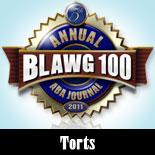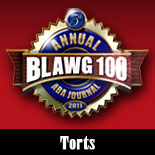We continue our series, “Abnormal Interviews,” in which we conduct brief interviews with law professors, practitioners and other commentators in the field. For this installment, we turn to John Hart, author of four bestselling novels, The King of Lies, Down River, The Last Child, and Iron House, which was released in late 2011. Hart describes himself as a “recovering attorney” who now devotes his efforts full-time to writing. We appreciate his taking the time for this interview.
1. One of the things that I thought was interesting about your most recent book, Iron House, was that the central character, Michael, had been an enforcer for a mob boss, yet he had good qualities, too. How did you strike a balance between those traits?
Well, the challenge that I had in writing this book right out of the gate was the question of how to make a stone cold killer redeemable in the eyes of the reader. Because what I wanted to do was explore the type of man that a traumatized child might become – the type of child who goes through hell and is never given a soft landing by the system, by his family, by society and he’s on his own from the earliest days. I wanted to explore the type of man that child would become and I had this idea of him growing into a life of serious crime and I knew right out of the gate that in order to make that character meaningful to the reader in any sort of positive way, he had to have some decent qualities. And it was a challenge. How to reconcile the kind of good qualities the readers want to see in a hero with the kind of qualities that would allow him to be a stone cold killer for 30 years or 20 years or whatever it was. And that’s all about what made him who he was. It was about the childhood of events that shaped him and how he clung to good parts of who he perceived himself to be throughout that.
2. What kind of response have you gotten from your readers for Iron House in comparison to your previous books?
Well, it’s interesting. The first three books were all about normal people trying to find the strength to deal with difficult but abnormal circumstances. This is the first character I’ve ever written that had a skill set. I mean, this is a dangerous man who knew exactly who he was and what he was capable of doing. And so it’s very different right out of the gate than the books I had written before. The reaction has actually been quite positive because he’s a much more recognizable thriller character. Most thrillers are about people that know how to get the job done in one capacity or another and people really responded well to him. Better than I thought. I was afraid that I had contrived to shoot myself in the foot by writing about a person capable of such cruelties but I seem to have found the right balance based on how readers have responded.
3. I have read all four of your books and it seemed to me the storyline in Iron House was a little darker. You had the orphans, the mob, the crime, the violence. I was interested in how you would describe it as being different from your previous books.
It was a conscious decision in that I felt that the first three books, by the traditional definition, should not necessarily work as thrillers. “Work,” in the first novel, a sort of broken down lawyer, is atypical for a thriller. Certainly, a 13-year-old child, in the third novel, Last Child, is atypical. So I wanted to try to write something that was more immediately recognizable but still give the books the qualities that made the first three work which, in my opinion, is a certain amount of character depth and that was a lot of fun trying to write this guy in a way that people could relate to and still make him a total badass. I’ve never written a bad-ass before.
4. I read somewhere that you almost walked away from writing Iron House. What did you mean by that?
It’s exactly what we’ve been talking about. I knew from page 1 that in order for the book to work, the character had to be likeable. And I knew that that was a hard order to fill and so I felt like, at 140 pages in, just convinced that it was impossible to make a meaningful, personal relationship between the reader and a character capable of such cold violence. And so I just became convinced that it was wasted effort and I need to move on to something else and I’m obviously glad that I didn’t move on. But it was tough to find a compelling voice that felt real when dealing with a professional killer because I obviously know nothing about what it takes to be a professional killer. It’s truly imagination. And I like for readers to feel that my characters are fairly real and so I just lost faith that this guy would feel like a real character. I did something I normally would never do. I rarely show anything to my publisher until it’s finished. They like to have a fresh read and so I – at page 140 – I asked my editor and my publisher to read it and tell me if I should walk away or continue. I’ll never forget the conversation I had with my publisher. He just thought it was fabulous and he said I understand your concerns but you have the talent to pull this off in a major way, is what he said. And that really kept me involved.
5. Did you do any research before writing Iron House?
No, not really. There was certainly temptation to do research on the mob and stuff like that, but most of my fiction, I write it so that it doesn’t require a tremendous amount of research. The example I usually like to use, I rarely get into the specifics of weapons, for instance. If I write about a gun, it’s usually small and shiny or large and rustic with a shine on the hammer or brutish and square, something that’s not specific. I write from the internal landscape of the characters. In Iron House, for instance, how does Michael feel about what he does? How does he see his place in the world becomes much more important to me than exactly how does he do his job or where does he go to get his weapons or his information. So I just write in the way that didn’t require a lot of that. Of course, I’m always prepared to look for it if I felt I needed it. But its one of the things – my books are fairly uniform and it’s really all about the character. It’s about what they care about, what they see and what drives them and how they relate to the world around them. And that doesn’t require as much specific information as you might think.
6. Was there anything about the writing of Iron House that drew upon your prior career as a lawyer?
Not Iron House so much. Certainly King of Lies, to a degree, smaller than that, Down River. Last Child and Iron House really did not have any specific draw from my legal training. They all drew from my legal experience. I was in the criminal system for a while and what I learned in that time is more about what motivates people to do bad things and it’s usually not as grand as you might imagine. I like to think there are no criminal masterminds. It’s usually by the end of the book we find that things are done for reasons that are fairly predictable. Even in something like Iron House, it’s a much grander scale than my previous books, and I think that holds true.
7. Your first novel was The King of Lies, and the central character, Work Pickens, was a lawyer, but he did not seem to enjoy the practice of law very much.
No. I wrote that book literally on the heels of my own law practice. I’d been a few years in the criminal courts and quit to write The King of Lies. I never felt great about my job in the criminal system. I’m much more geared to the mindset of a prosecutor than a defense attorney. Defense work was the job that I found, so I did it and I enjoyed it to a point but I never really felt great about it and obviously the fact that I was willing to walk away from it in order to pursue something as risky as writing a novel is fairly indicative of the depth of my feelings and those feelings very much spilled over into “Work.”
8. My favorite John Hart book is probably The Last Child, in which the main character was a kid named “Johnny.”
Well, Johnny’s my favorite character, too, and The Last Child is probably my favorite book. Johnny was a challenge in that it’s very risky to write an adult thriller based around a child. I wanted to do that. The inspiration for Johnny actually came from Down River. If you remember in that novel, we see in the first few pages Adam Chase returning back to Rowan County after a long exile in New York and he stops at the river and while he’s there he meets this young boy who’s down to check some fishing lines that he and his father had put out the night before. And I love this kid. He was just sort of wholesome, innocent, unafraid child and it got me thinking about what might happen if you took away all that bubble of innocence that protected all that he seemed to move through and took all that away, what kind of child might he become. And so, that’s what got me thinking about Johnny. I needed to ask myself a couple of questions. If I did take away that life, that wonderful, perfect, innocent childhood, what would that do to him? Where would he find the strength to deal with those new circumstances and down what dangerous road might that strength carry him? You may remember Johnny’s best friend is Jack? Really, two sides of the same coin. Johnny, I think, is the kid we’d all sort of would like to be or wish we had been. Sort of clear eyed and selfless and brave. And Jack is the exact opposite. He smoked cigarettes, steals his daddy’s liquor, cut school. Johnny and Jack are both nicknames for John. That was not coincidental. I kind of feel like those boys were the two sides of me in a lot of ways and so one of the reasons that I love those characters so much in that book is that it all feels very personal to me in ways that others don’t.
9. How long does it take to write a novel such as Iron House? Did it take longer than the others?
The general ballpark is anywhere from 10 months to a year, seems to be about average. Iron House took more like 18. That’s because it took me a very long time to find a compelling voice for this killer. I started that novel nine different times trying to find the right voice for him. That took a lot of my time. Once I found the first 50 or 60 pages, it felt right. The rest of it took about eight months.
10. You have had four best-selling novels. Do you have anything in the works now?
Oh, yeah. Working on number five. It’s like anything else, you have to produce to get paid. This is my career now. It’s all I do and so I don’t like to sit idle for too long. It’s great because you can take time off between books and have a little more of a life than I ever did when I was working as a lawyer in terms of free time. But you can’t sit idle for too long. You have to produce.
11. You are married and have a couple of young children. How do you balance the family life with your writing time?
It’s not that hard. I have an office downtown and I generally get down there about six hours a day, maybe seven. Then the rest of the time I’m available to be with the kids and it’s very easy to take time off when I want to. The only time it gets to be problematic is when I tour, which happens for longer and longer periods. I do a lot of international travel now. That gets to be a little bit of a challenge for the family if I’m overseas for three or four weeks which happens seems like once or twice a year.
12. One of your great passions is the protection of your native North Carolina’s open spaces. What have you done to protect those open spaces?
I work with local land trust movements. I’m involved specifically with one in central North Carolina. It’s about educating the public about the benefits of conservation easements and it’s also about raising money to acquire property outright which is then often given to the Parks Service of the state to be preserved forever. So it’s kind of a grass roots effort to get communities involved in preserving what they have with their open spaces.
13. Bonus Question: Other than writing, what has been your favorite job?
Working at a London pub right out of college.
BIOGRAPHY: John Hart was born in Durham, North Carolina, and later moved to Rowan County, the setting for both The King of Lies and Down River. He is a graduate of Davidson College and later earned graduate degrees in accounting and law. He has worked as a criminal defense attorney, banker, stockbroker, and apprentice helicopter mechanic. He is a husband and father of two, and spends his time in North Carolina and Virginia. Hart is the only author to win the best novel Edgar Award for consecutive novels, and he has also won the Barry Award and England’s Steel Dagger Award for best thriller of the year.















